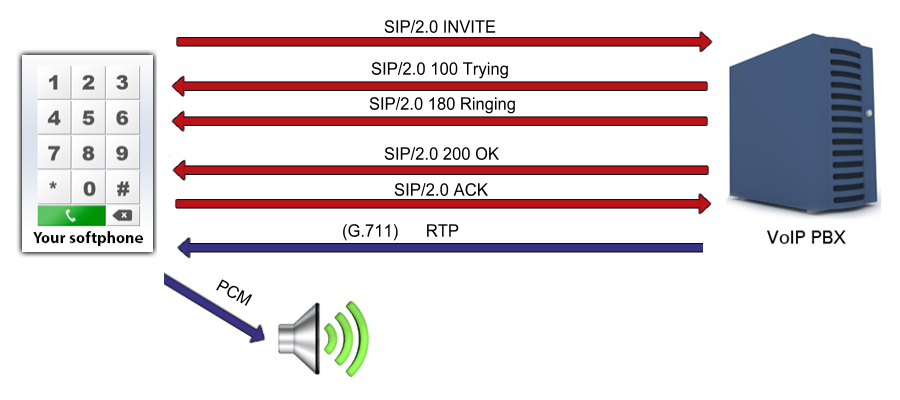How to receive voice data from SIP voice call using C# speaker?
 |
Download: | sdk-speaker.zip |
This example demonstrates how to get speaker using c#, how to connect
media handlers and attach speaker to call, how to receive and play audio stream
from a call in c#, using Ozeki VoIP SIP SDK.
To fully understand this example, you might have to study the
How to register to a SIP PBX chapter and the
How to ring a SIP extension chapter first.
To use this example, you need to have Ozeki VoIP SIP SDK installed,
and a reference to ozeki.dll should be added to your visual studio project.

What is speaker used for during a SIP voice call? How does it work?
A speaker is an electroacoustic transducer that produces sound in response to an electrical audio signal input. In other words, speakers convert electrical signals into audible signals.
Softphones are using speakers as audio receiver devices for the purpose to play the received voice stream through them. Since the audio voice stream arrives as digital numbers which are representing the quantity's amplitude, a digital-to-analog device automatically converts the received digital voice data to electrical signals, which the speaker can send into the air as sound.
How to access speaker and play audio stream as sound using c#?
Ozeki VoIP SIP SDK provides C# Speaker class for the purpose to create speaker object. With this c# virtual speaker, users are able to reach system speaker and change speaker volume, manage speaker sound. A speaker object is able to be attached to a call with the correct media receiver object, to play the received audio from the call.
Connect speaker to call example in C#
using System;
using Ozeki.Media;
using Ozeki.VoIP;
namespace SDK_Speaker
{
class Program
{
static ISoftPhone softphone; // softphone object
static IPhoneLine phoneLine; // phoneline object
static IPhoneCall call;
static Speaker speaker;
static MediaConnector connector;
static PhoneCallAudioReceiver mediaReceiver;
private static void Main(string[] args)
{
// Create a softphone object with RTP port range 5000-10000
softphone = SoftPhoneFactory.CreateSoftPhone(5000, 10000);
// SIP account registration data, (supplied by your VoIP service provider)
var registrationRequired = true;
var userName = "858";
var displayName = "858";
var authenticationId = "858";
var registerPassword = "858";
var domainHost = "192.168.115.100";
var domainPort = 5060;
var account = new SIPAccount(registrationRequired, displayName, userName, authenticationId, registerPassword, domainHost, domainPort);
// Send SIP regitration request
RegisterAccount(account);
speaker = Speaker.GetDefaultDevice();
mediaReceiver = new PhoneCallAudioReceiver();
connector = new MediaConnector();
// Prevents the termination of the application
Console.ReadLine();
}
static void RegisterAccount(SIPAccount account)
{
try
{
phoneLine = softphone.CreatePhoneLine(account);
phoneLine.RegistrationStateChanged += line_RegStateChanged;
softphone.RegisterPhoneLine(phoneLine);
}
catch (Exception ex)
{
Console.WriteLine("Error during SIP registration: " + ex);
}
}
static void line_RegStateChanged(object sender, RegistrationStateChangedArgs e)
{
if (e.State == RegState.NotRegistered || e.State == RegState.Error)
Console.WriteLine("Registration failed!");
if (e.State == RegState.RegistrationSucceeded)
{
Console.WriteLine("Registration succeeded - Online!");
CreateCall();
}
}
private static void CreateCall()
{
var numberToDial = "853";
call = softphone.CreateCallObject(phoneLine, numberToDial);
call.CallStateChanged += call_CallStateChanged;
call.Start();
}
private static void SetupSpeaker()
{
connector.Connect(mediaReceiver, speaker);
mediaReceiver.AttachToCall(call);
speaker.Start();
Console.WriteLine("The speaker is functioning.");
}
static void call_CallStateChanged(object sender, CallStateChangedArgs e)
{
Console.WriteLine("Call state: {0}.", e.State);
if (e.State == CallState.Answered)
SetupSpeaker();
}
}
}
Communication through the network
When the call has been accepted by the called party, the softphone is ready to receive the voice stream from the source through the UDP network as RTP packages. This example also writes to the console that the speaker has been successfully started.
Step 1: the application notifies the user about the success of starting the speaker
The speaker is functioning.
Step 2: RTP packages are being received from the source (a sample package)
[Stream setup by SDP (frame 28)] 10.. .... = Version: RFC 1889 Version (2) ..0. .... = Padding: False ...0 .... = Extension: False .... 0000 = Contributing source identifiers count: 0 1... .... = Marker: True Payload type: ITU-T G.711 PCMU (0) Sequence number: 7133 [Extended sequence number: 72669] Timestamp: 85000 Synchronization Source identifier: 0x712f7356 (1898935126) Payload: d55555545657545756565455575051575650515557515050...
